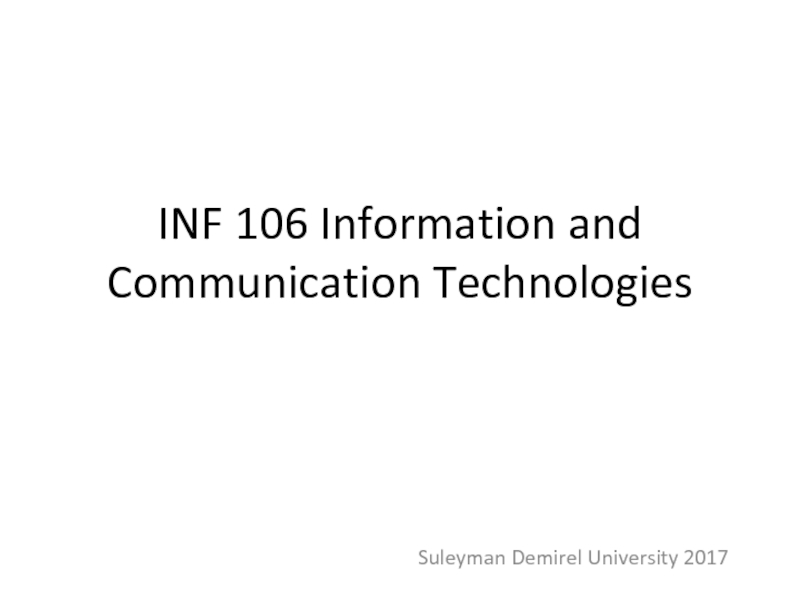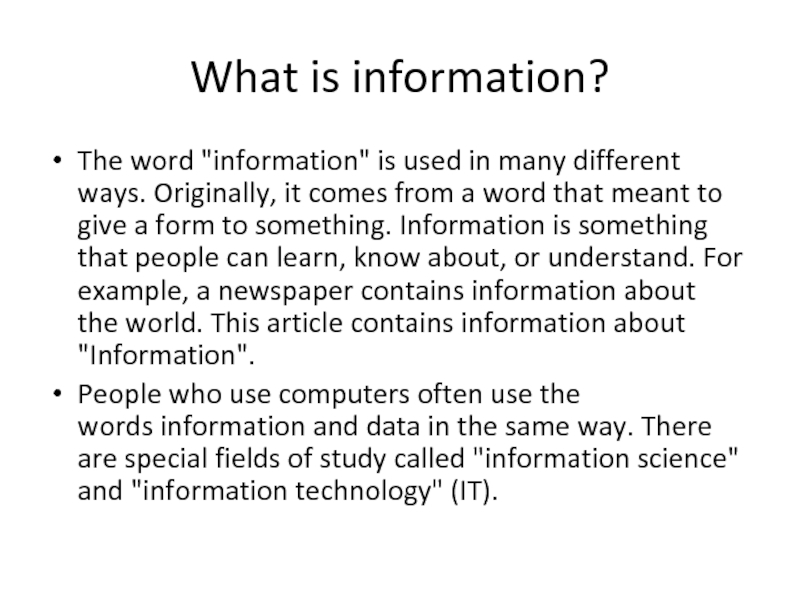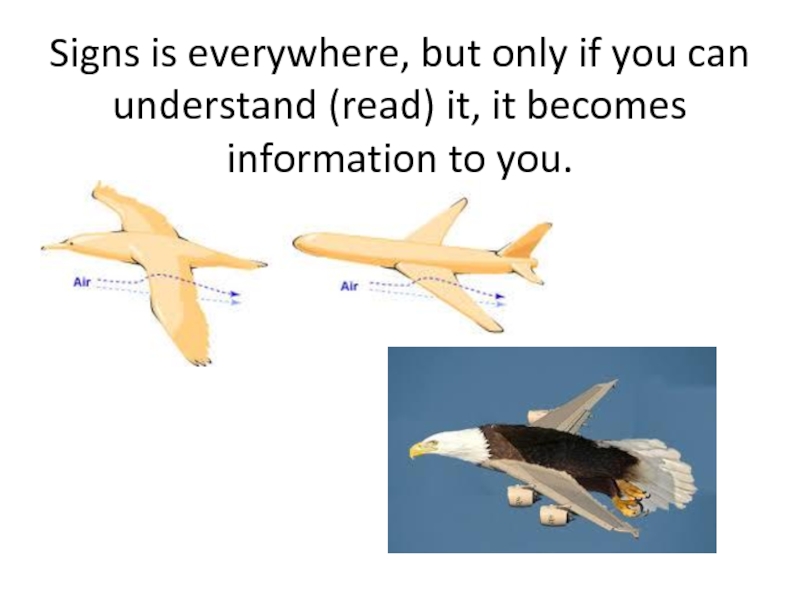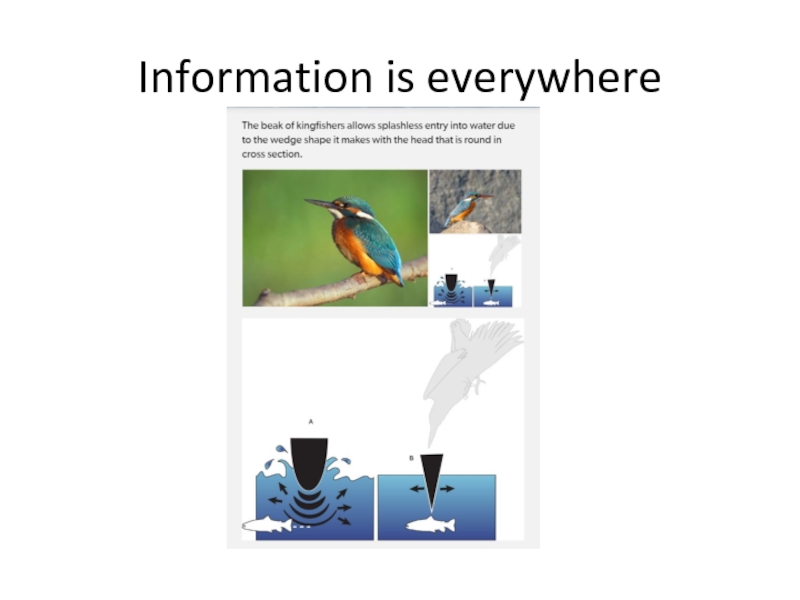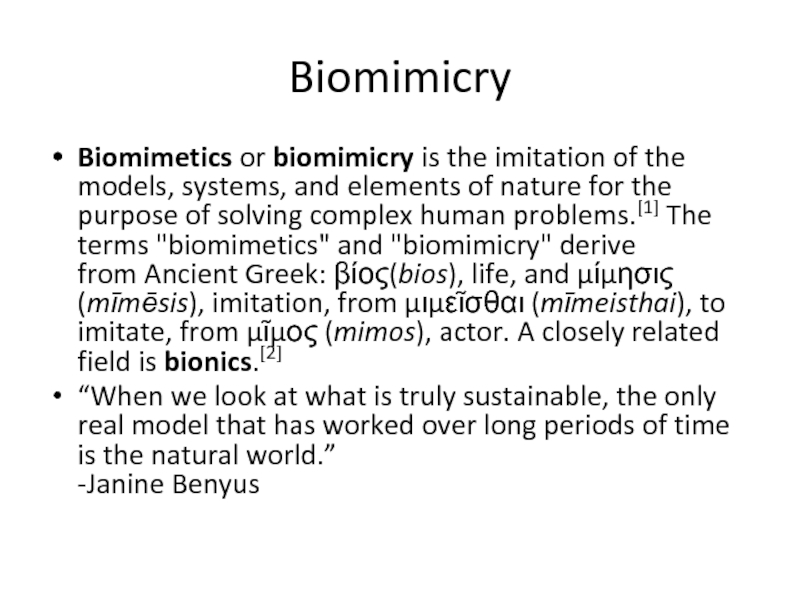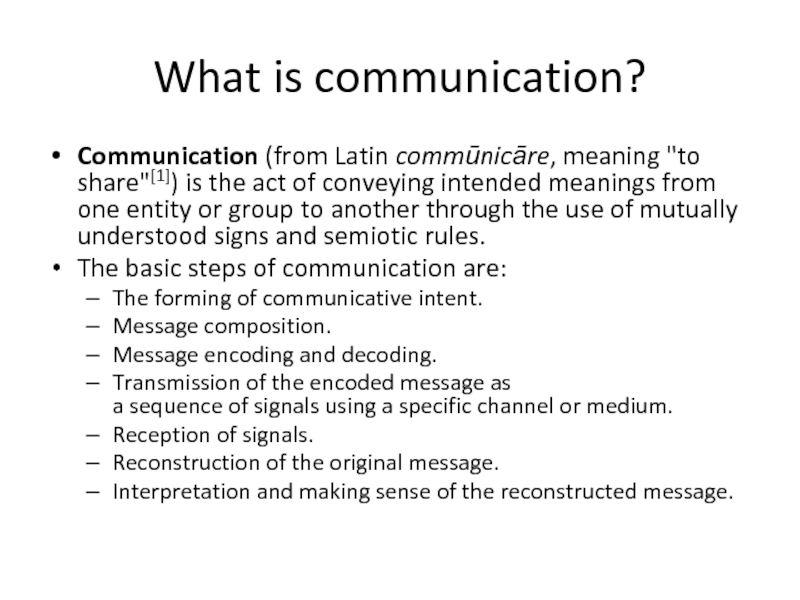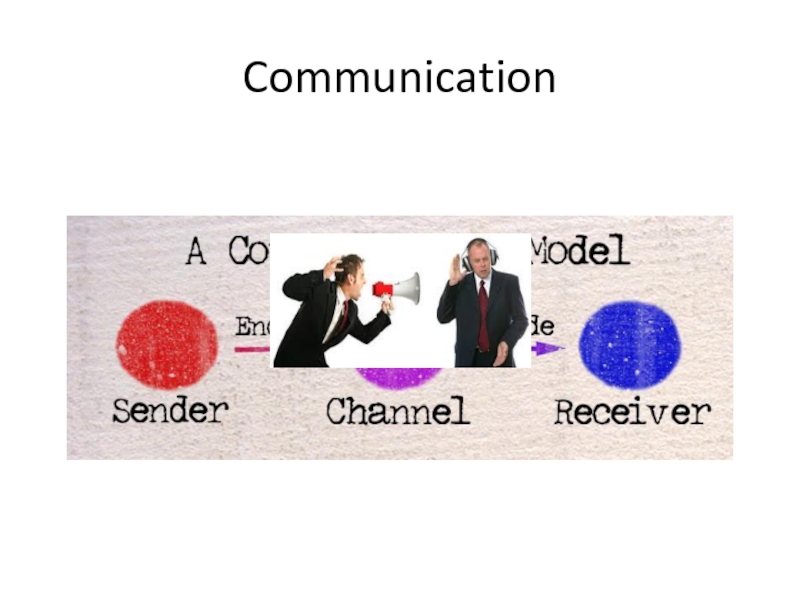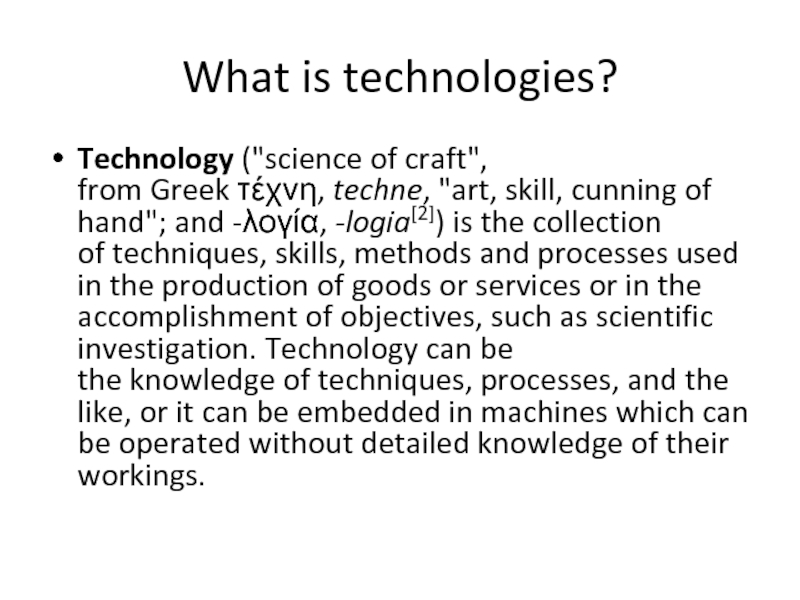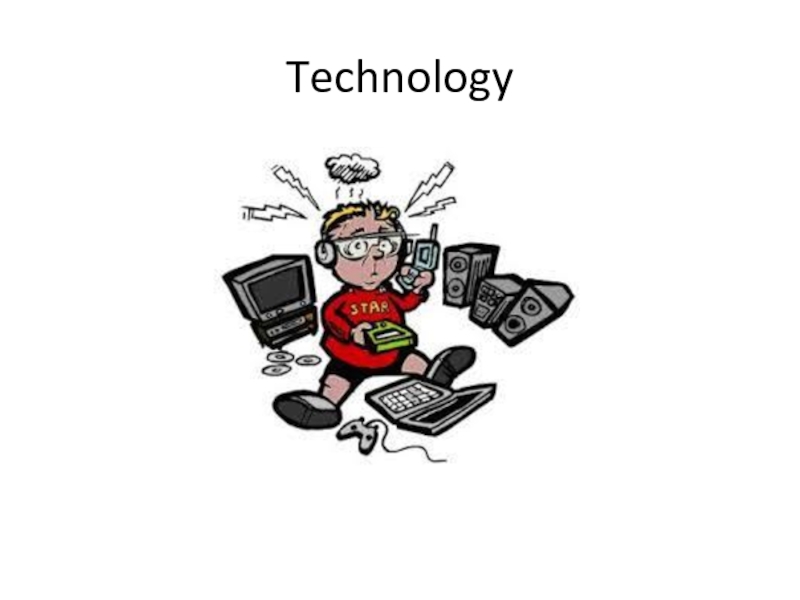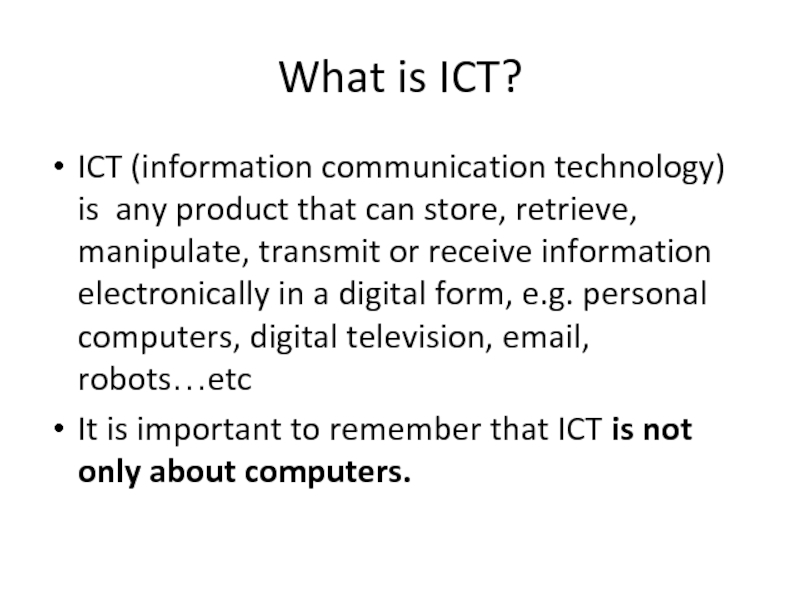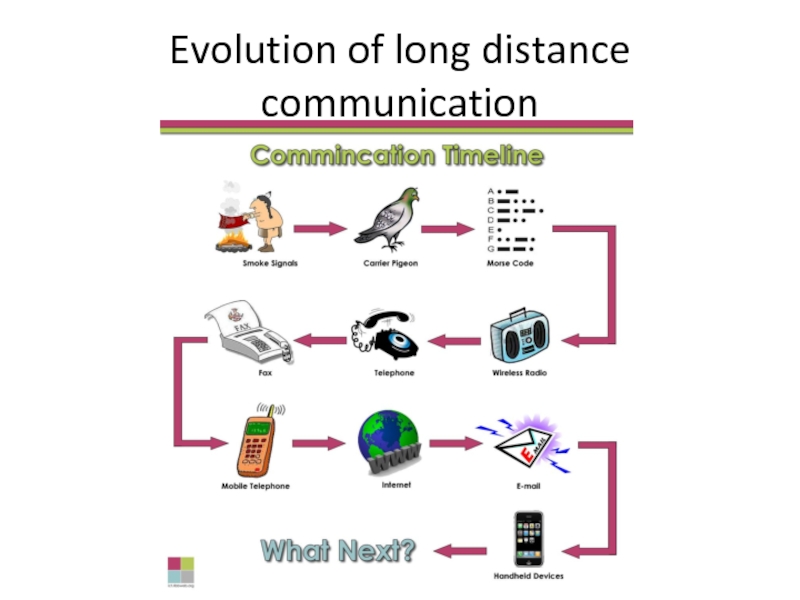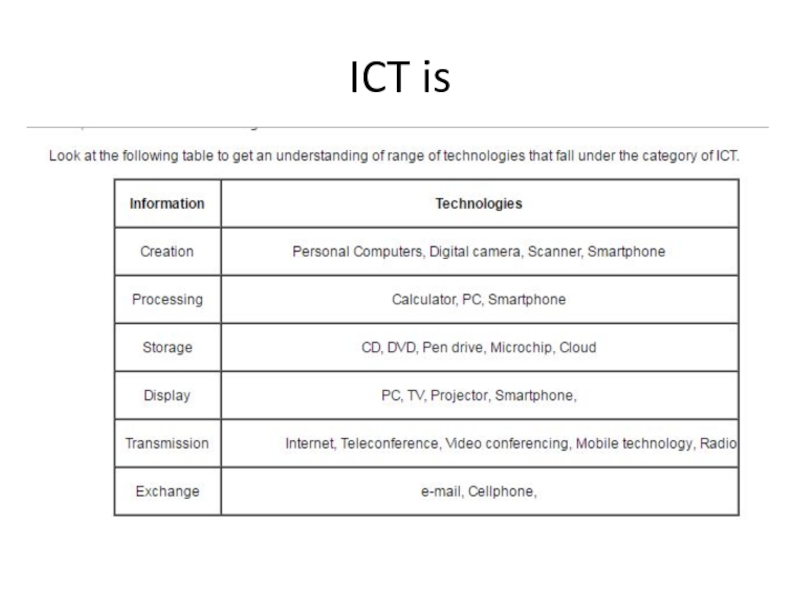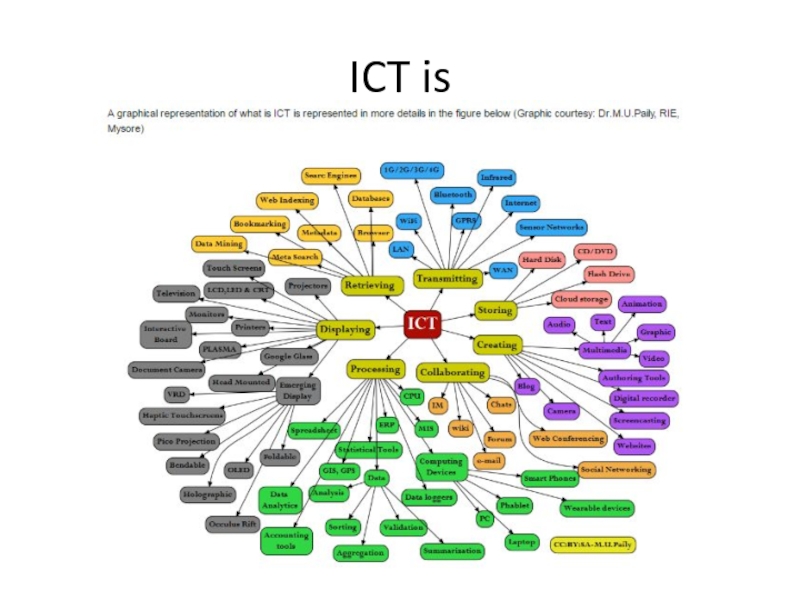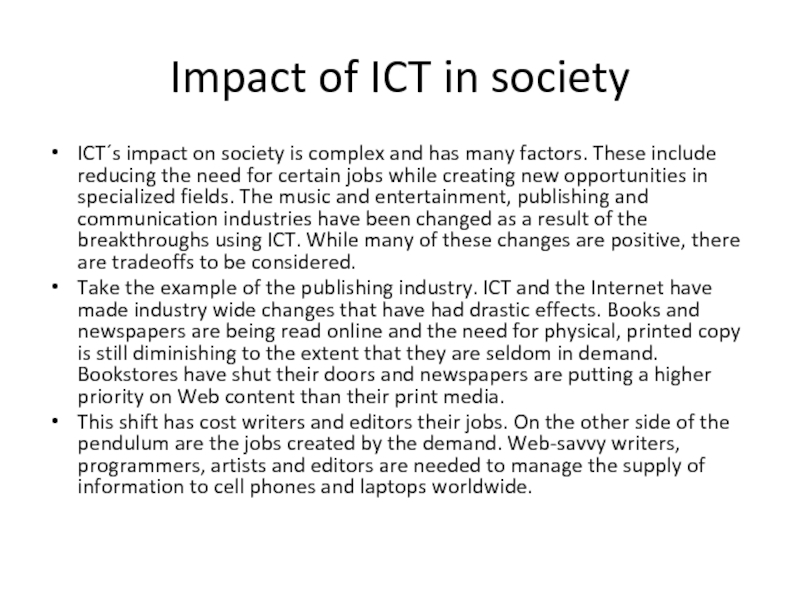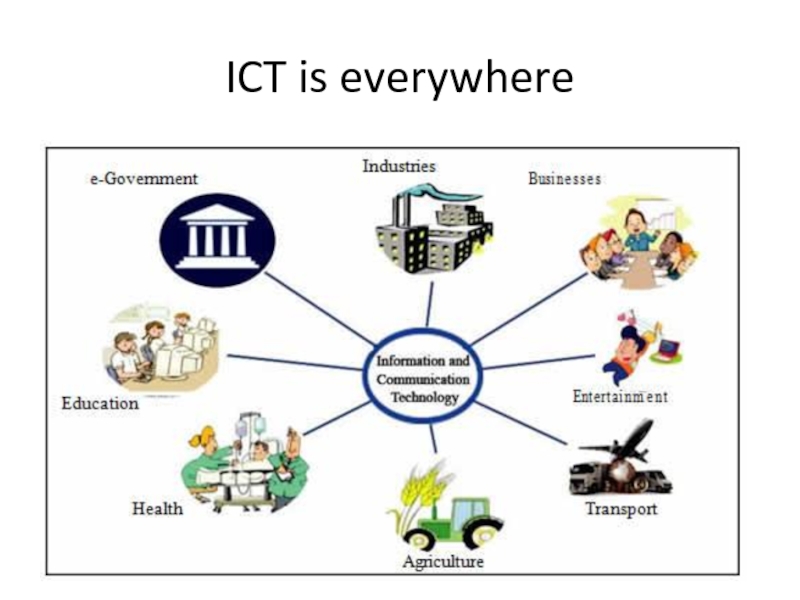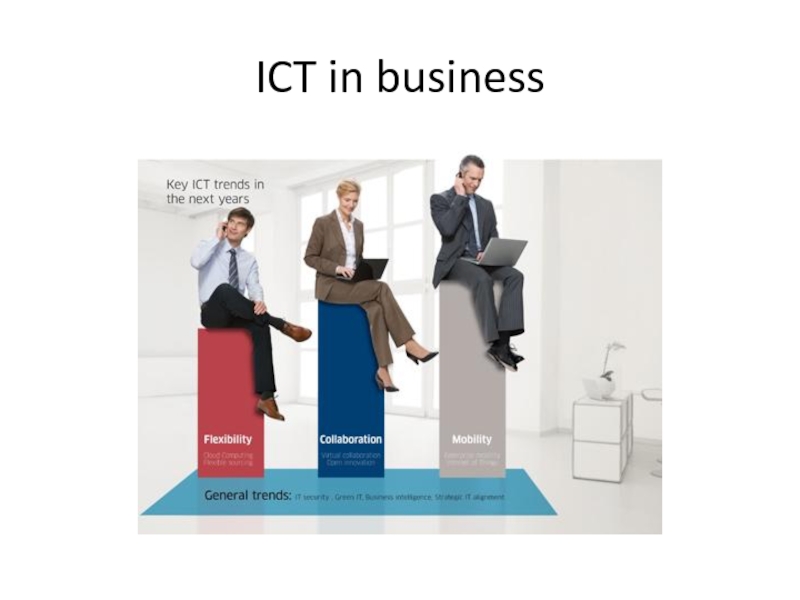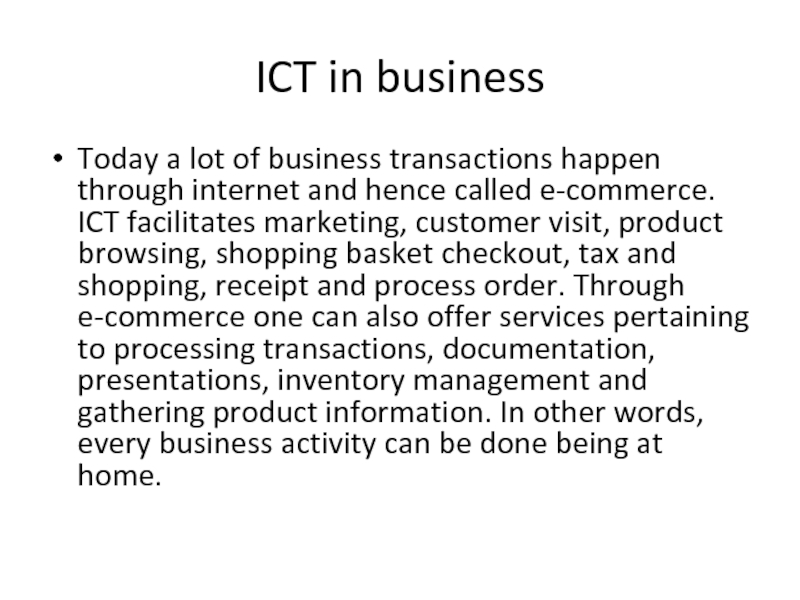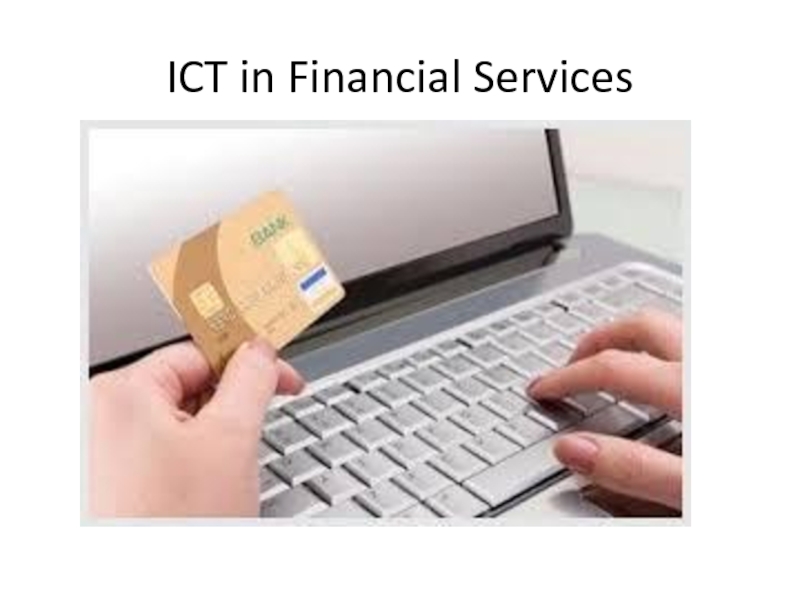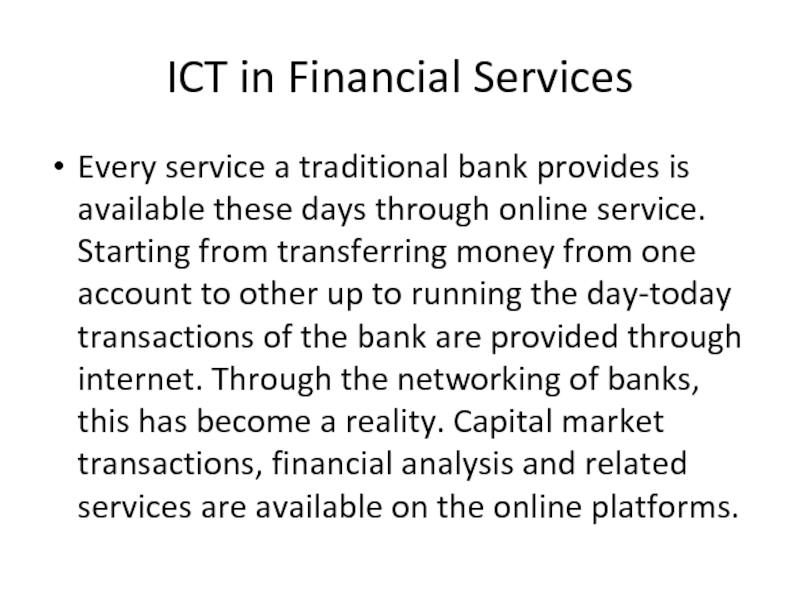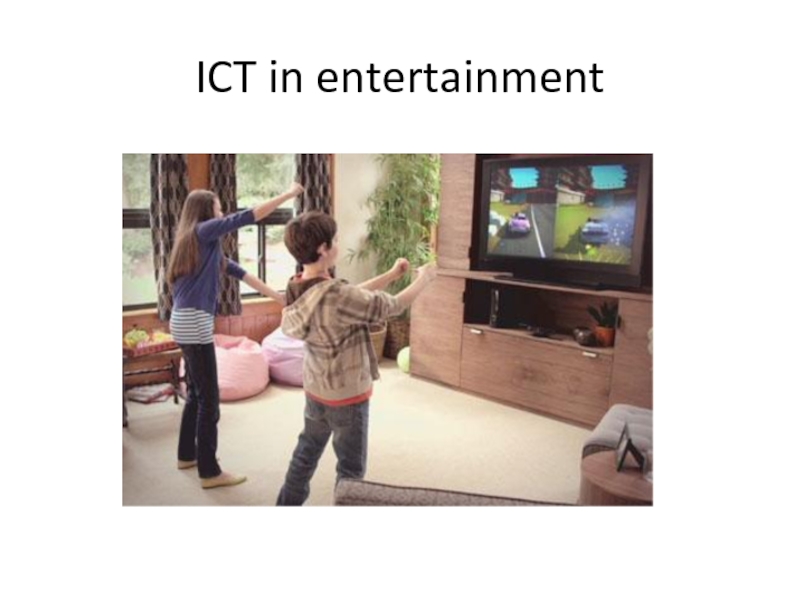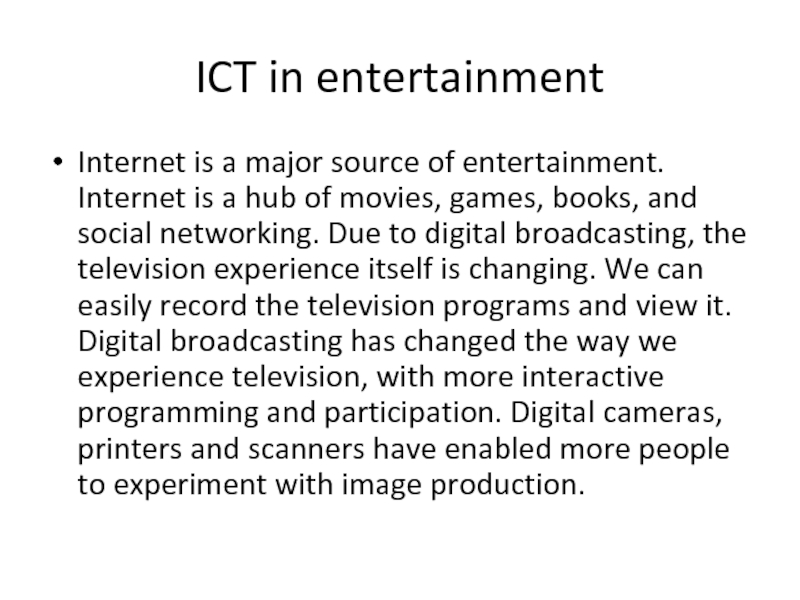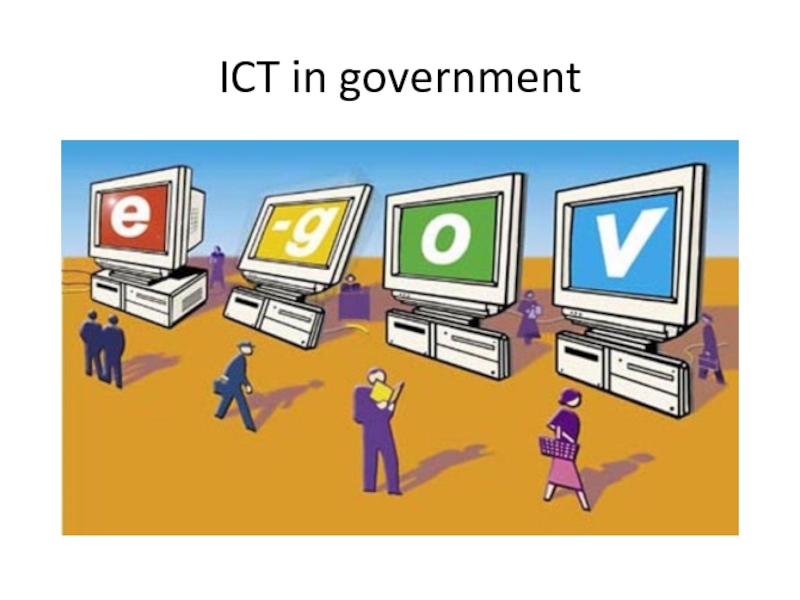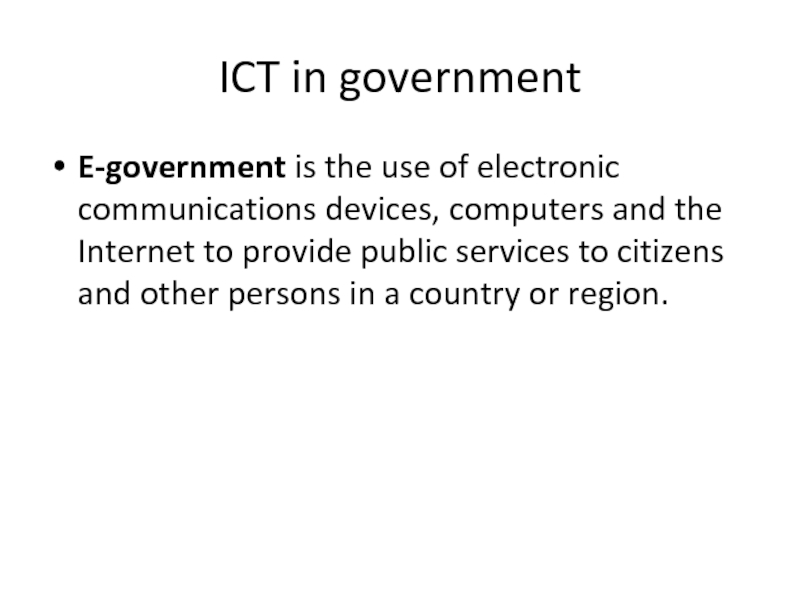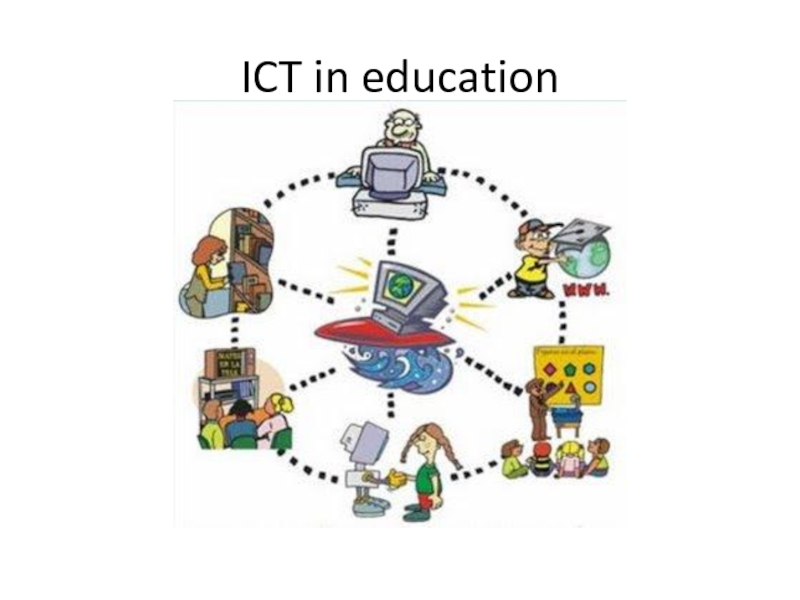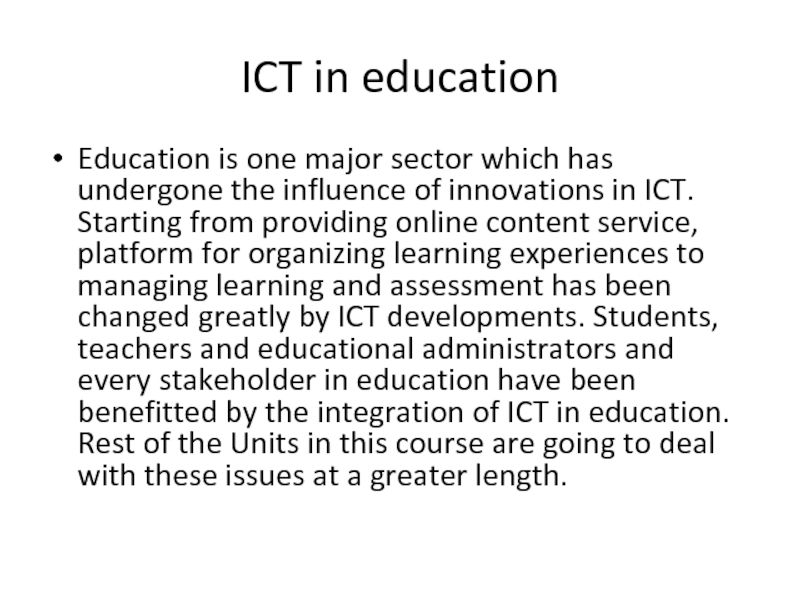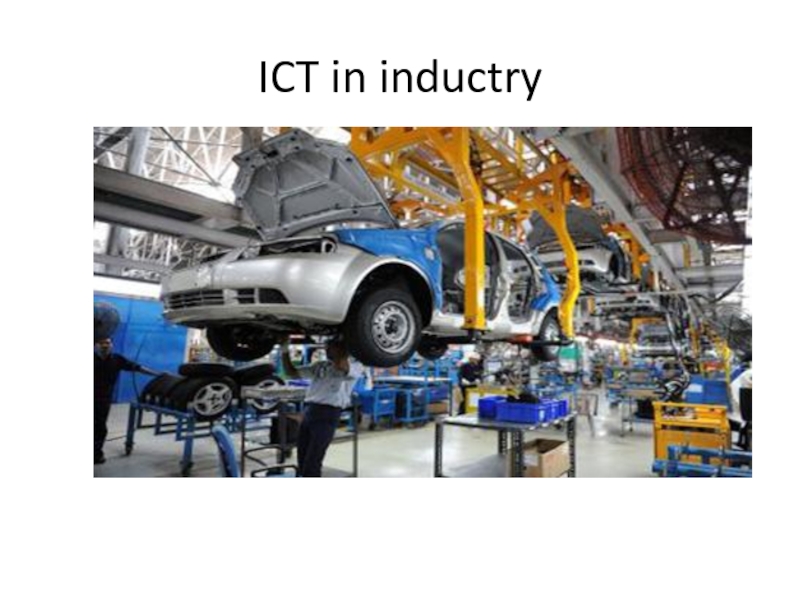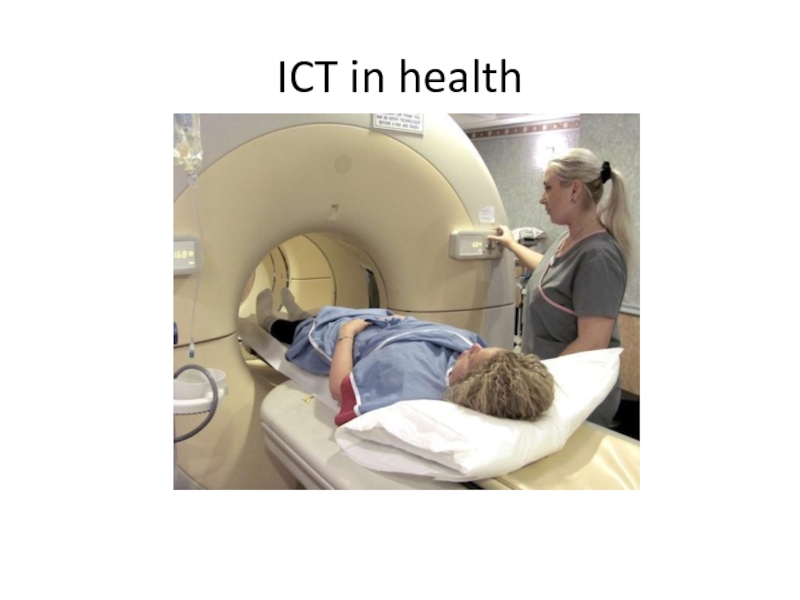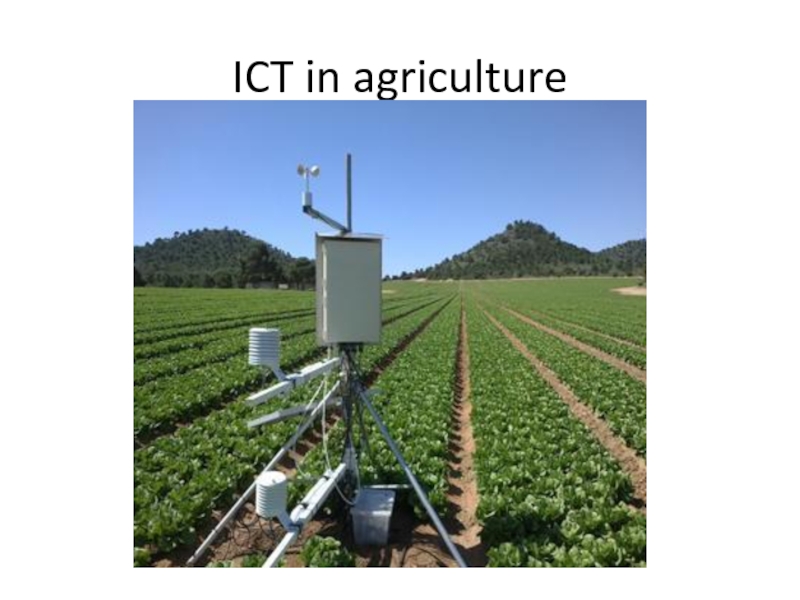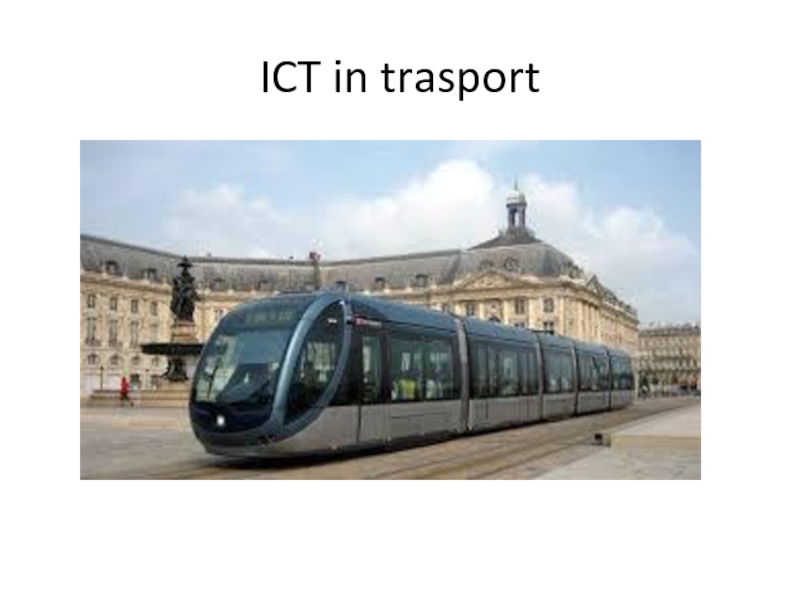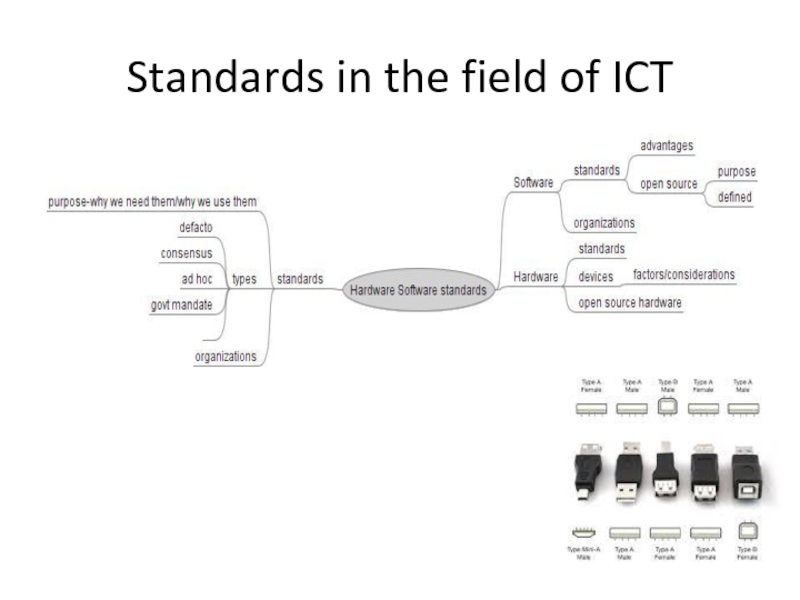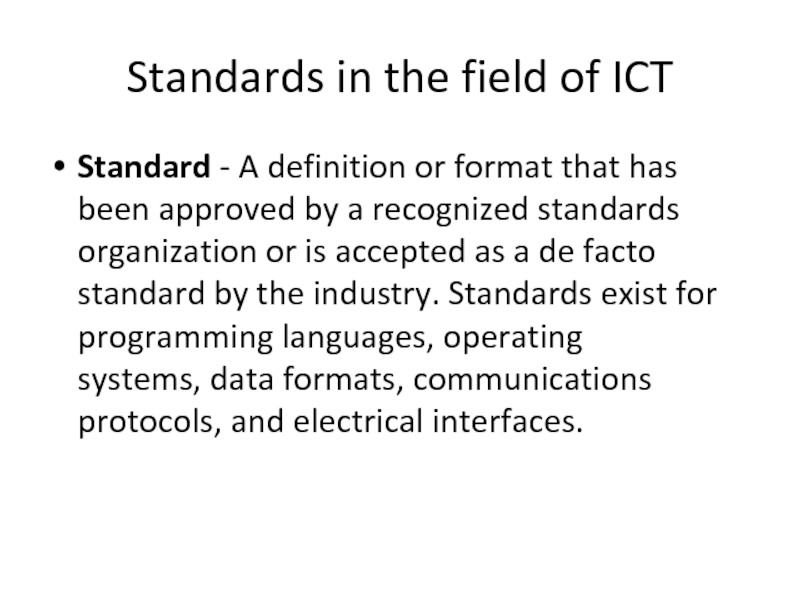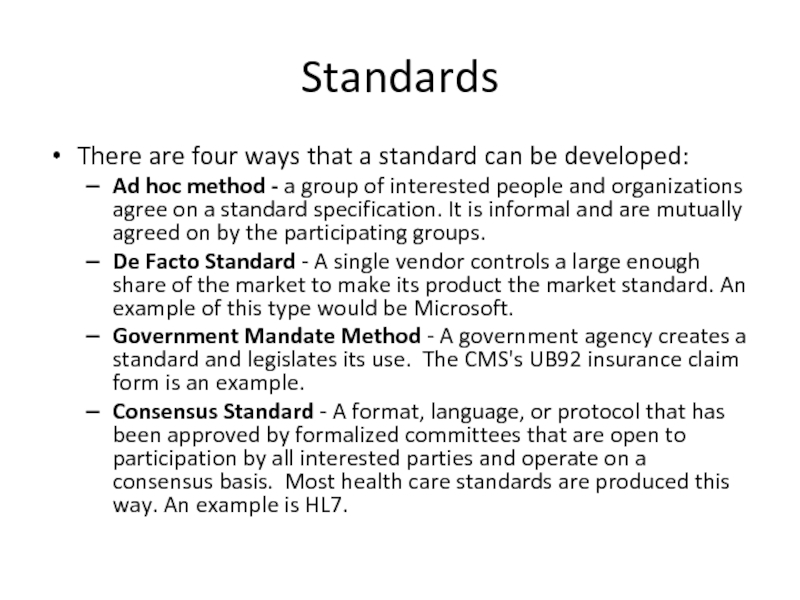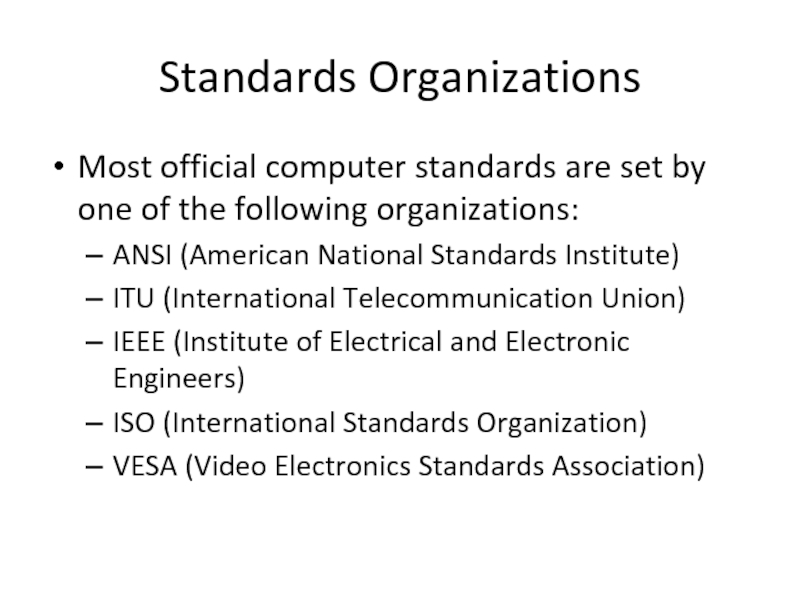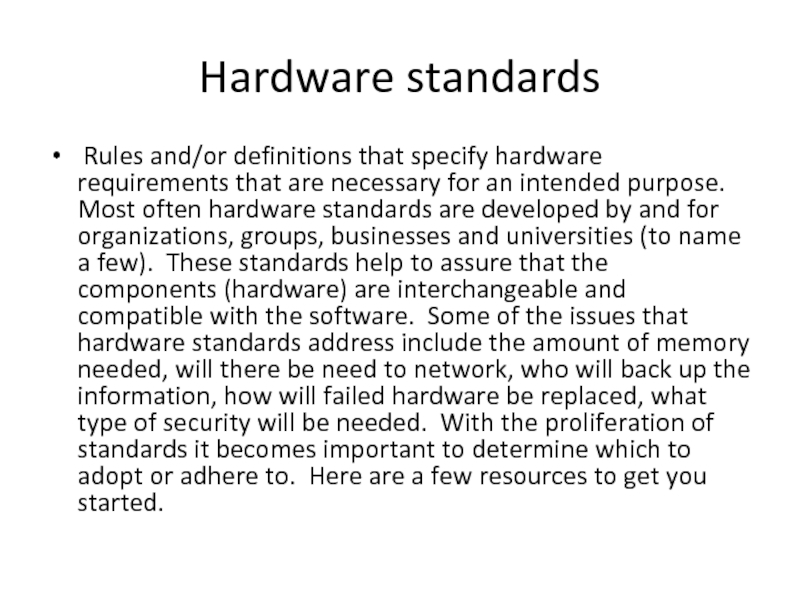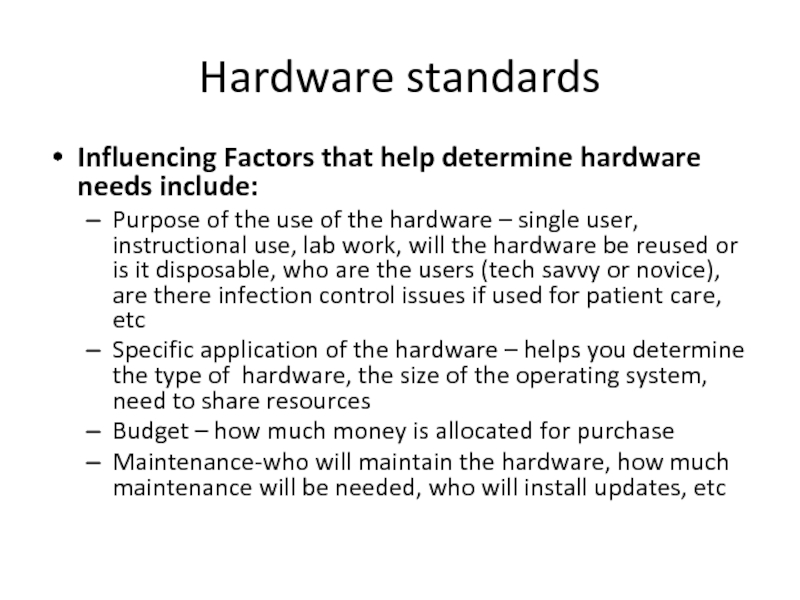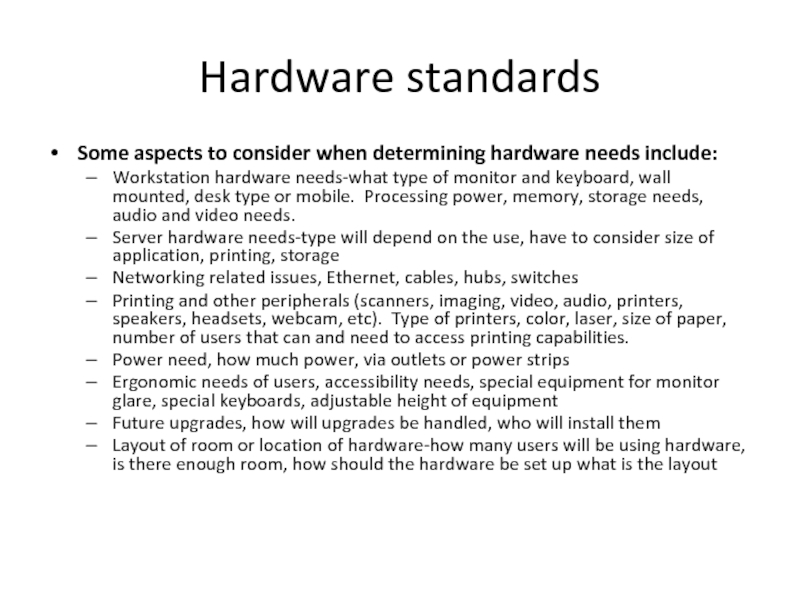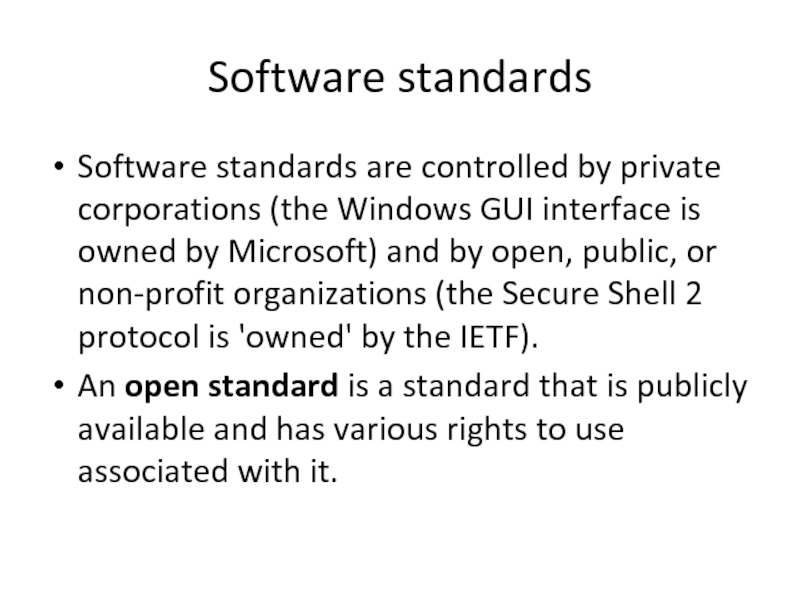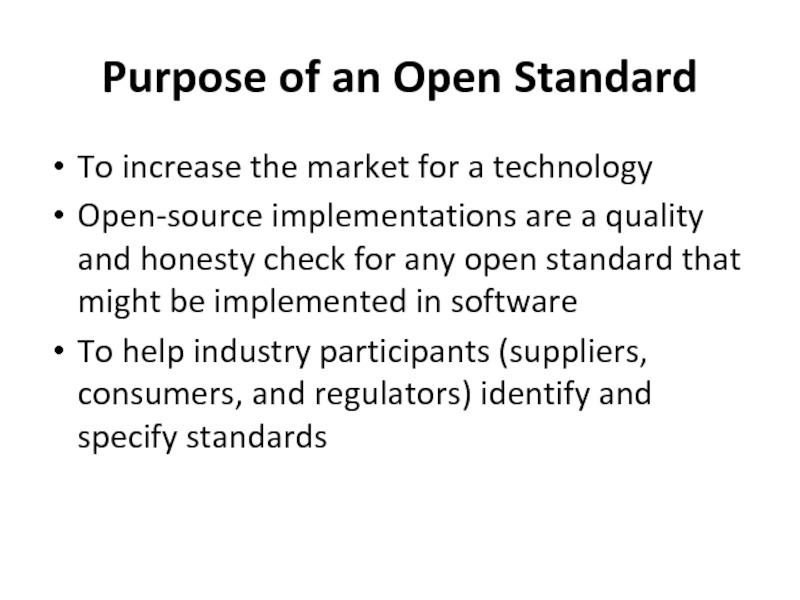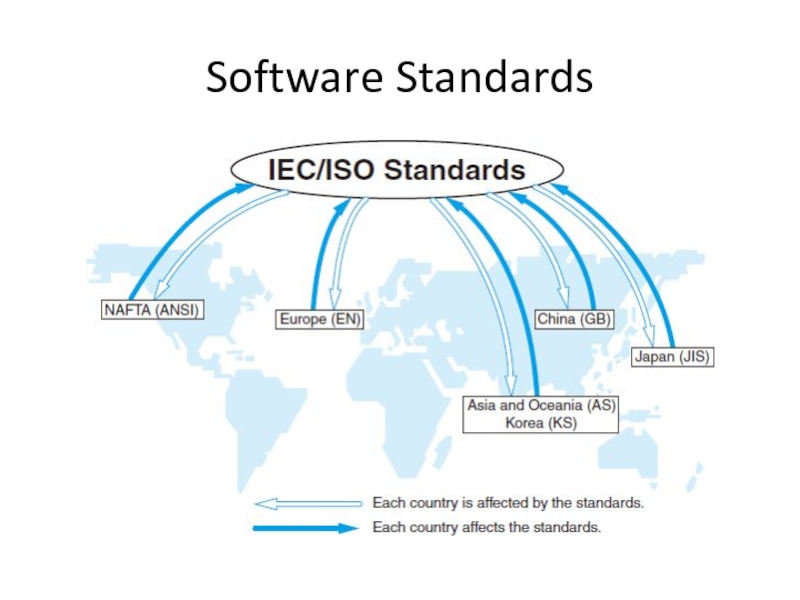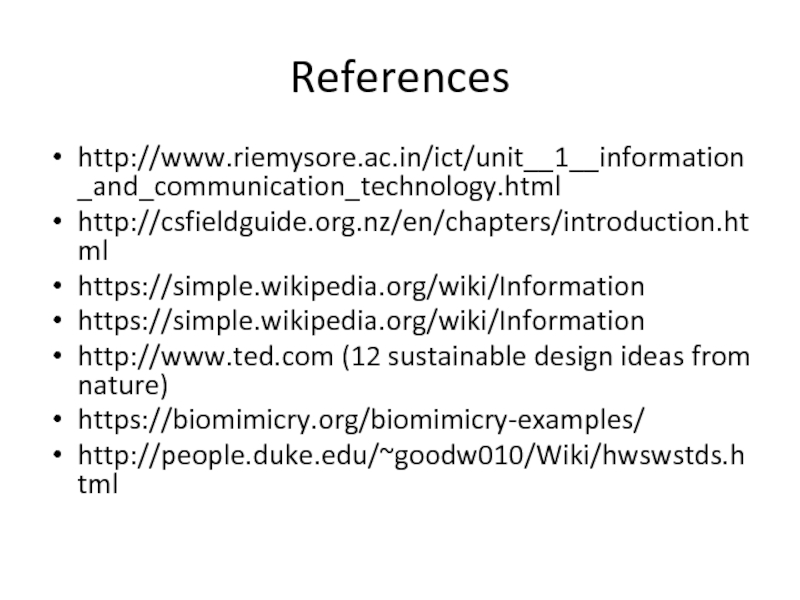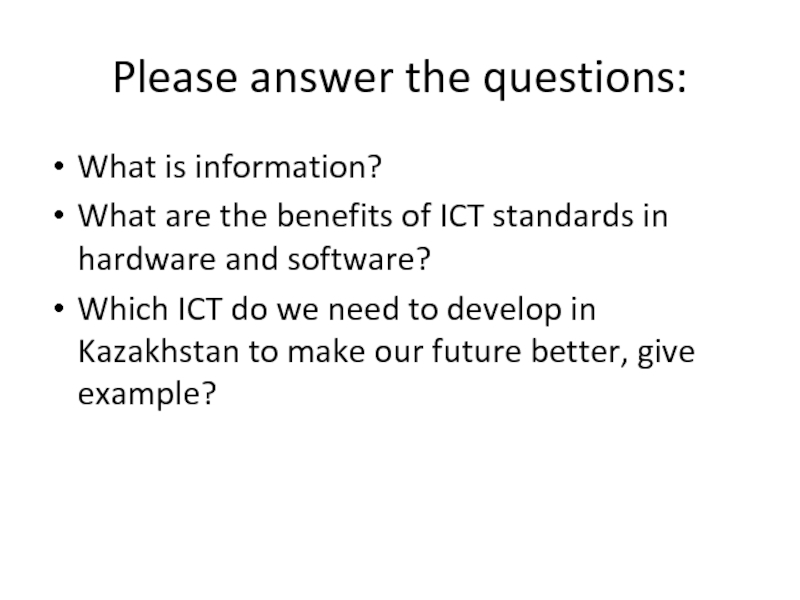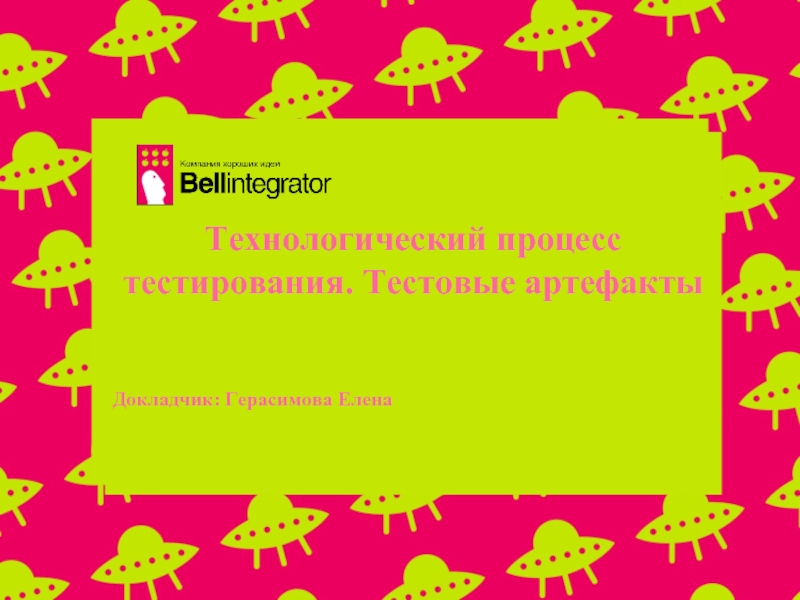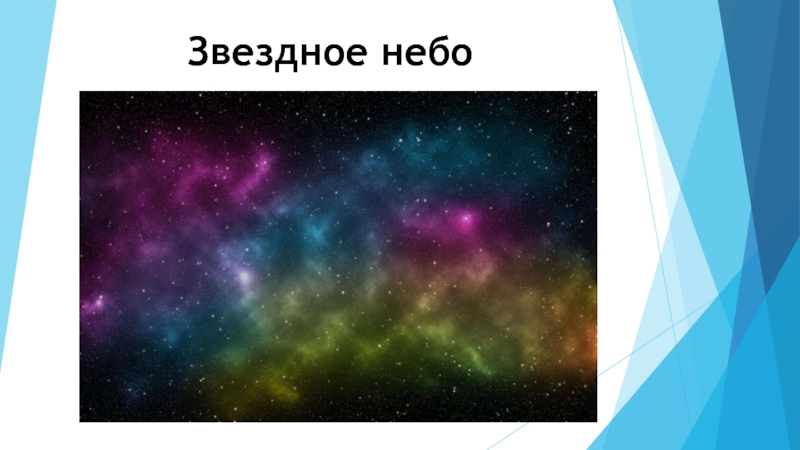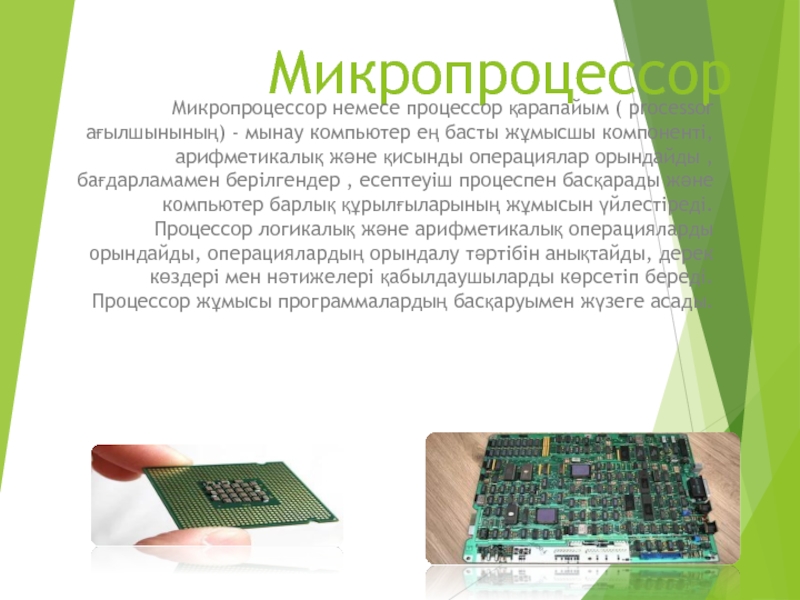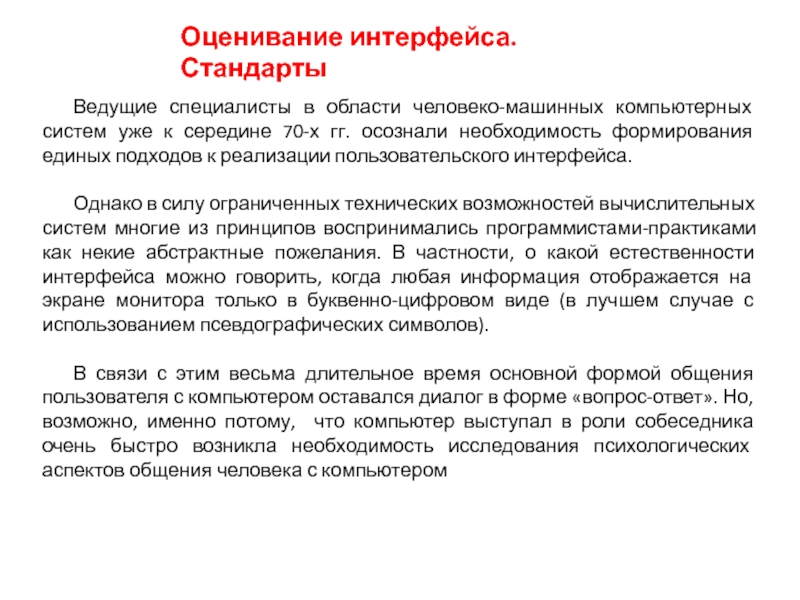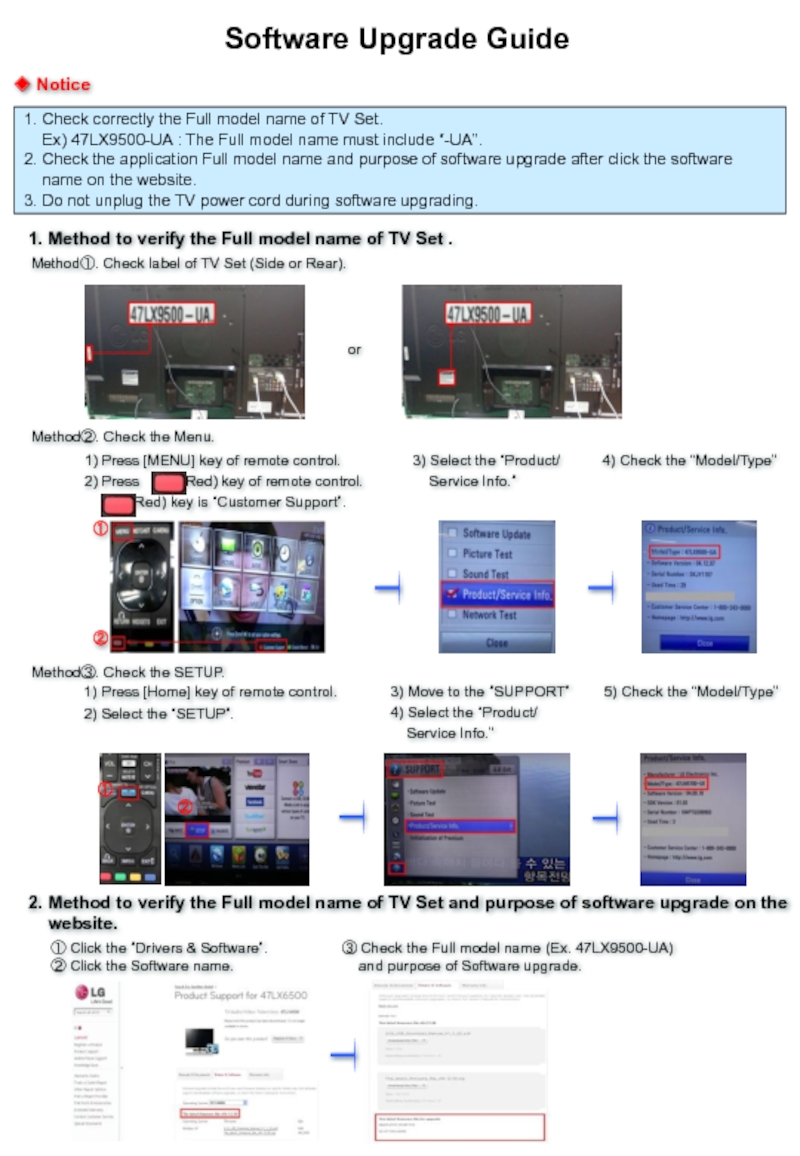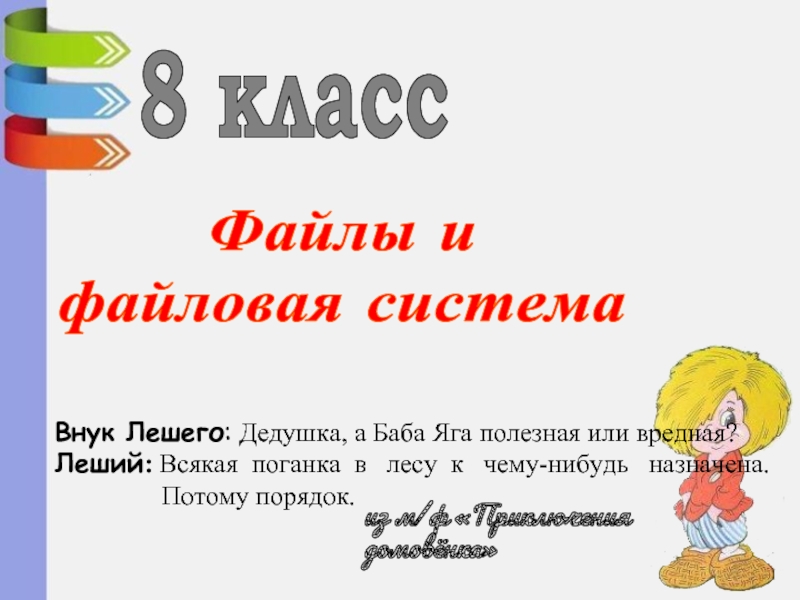- Главная
- Разное
- Дизайн
- Бизнес и предпринимательство
- Аналитика
- Образование
- Развлечения
- Красота и здоровье
- Финансы
- Государство
- Путешествия
- Спорт
- Недвижимость
- Армия
- Графика
- Культурология
- Еда и кулинария
- Лингвистика
- Английский язык
- Астрономия
- Алгебра
- Биология
- География
- Детские презентации
- Информатика
- История
- Литература
- Маркетинг
- Математика
- Медицина
- Менеджмент
- Музыка
- МХК
- Немецкий язык
- ОБЖ
- Обществознание
- Окружающий мир
- Педагогика
- Русский язык
- Технология
- Физика
- Философия
- Химия
- Шаблоны, картинки для презентаций
- Экология
- Экономика
- Юриспруденция
Information and Communication Technologies презентация
Содержание
- 1. Information and Communication Technologies
- 2. What is information? The word "information" is
- 3. Signs is everywhere, but only if you
- 4. Everything that invented by human have disadvantage.
- 5. Information is everywhere
- 6. Biomimicry Biomimetics or biomimicry is the imitation of the models,
- 7. What is communication? Communication (from Latin commūnicāre, meaning "to
- 8. Communication
- 9. What is technologies? Technology ("science of craft", from Greek τέχνη, techne,
- 10. Technology
- 11. What is ICT? ICT (information communication technology)
- 12. Evolution of long distance communication
- 13. ICT is
- 14. ICT is
- 15. Impact of ICT in society ICT´s impact
- 16. ICT is everywhere
- 17. ICT in business
- 18. ICT in business Today a lot of
- 19. ICT in Financial Services
- 20. ICT in Financial Services Every service a
- 21. ICT in entertainment
- 22. ICT in entertainment Internet is a major
- 23. ICT in government
- 24. ICT in government E-government is the use of
- 25. ICT in education
- 26. ICT in education Education is one major
- 27. ICT in inductry
- 28. ICT in health
- 29. ICT in agriculture
- 30. ICT in trasport
- 31. Standards in the field of ICT
- 32. Standards in the field of ICT Standard -
- 33. Standards There are four ways that a
- 34. Standards Organizations Most official computer standards are set by
- 35. Hardware standards Rules and/or definitions that specify
- 36. Hardware standards Influencing Factors that help determine hardware
- 37. Hardware standards Some aspects to consider when determining hardware
- 38. Software Standards The advantages of software standards
- 39. Software standards Software standards are controlled
- 40. Purpose of an Open Standard To increase
- 41. Software Standards
- 42. References http://www.riemysore.ac.in/ict/unit__1__information_and_communication_technology.html http://csfieldguide.org.nz/en/chapters/introduction.html https://simple.wikipedia.org/wiki/Information https://simple.wikipedia.org/wiki/Information http://www.ted.com (12 sustainable design ideas from nature) https://biomimicry.org/biomimicry-examples/ http://people.duke.edu/~goodw010/Wiki/hwswstds.html
- 43. Please answer the questions: What is information?
Слайд 2What is information?
The word "information" is used in many different ways.
Originally, it comes from a word that meant to give a form to something. Information is something that people can learn, know about, or understand. For example, a newspaper contains information about the world. This article contains information about "Information".
People who use computers often use the words information and data in the same way. There are special fields of study called "information science" and "information technology" (IT).
People who use computers often use the words information and data in the same way. There are special fields of study called "information science" and "information technology" (IT).
Слайд 3Signs is everywhere, but only if you can understand (read) it,
it becomes information to you.
Слайд 6Biomimicry
Biomimetics or biomimicry is the imitation of the models, systems, and elements of nature
for the purpose of solving complex human problems.[1] The terms "biomimetics" and "biomimicry" derive from Ancient Greek: βίος(bios), life, and μίμησις (mīmēsis), imitation, from μιμεῖσθαι (mīmeisthai), to imitate, from μῖμος (mimos), actor. A closely related field is bionics.[2]
“When we look at what is truly sustainable, the only real model that has worked over long periods of time is the natural world.” -Janine Benyus
“When we look at what is truly sustainable, the only real model that has worked over long periods of time is the natural world.” -Janine Benyus
Слайд 7What is communication?
Communication (from Latin commūnicāre, meaning "to share"[1]) is the act of
conveying intended meanings from one entity or group to another through the use of mutually understood signs and semiotic rules.
The basic steps of communication are:
The forming of communicative intent.
Message composition.
Message encoding and decoding.
Transmission of the encoded message as a sequence of signals using a specific channel or medium.
Reception of signals.
Reconstruction of the original message.
Interpretation and making sense of the reconstructed message.
The basic steps of communication are:
The forming of communicative intent.
Message composition.
Message encoding and decoding.
Transmission of the encoded message as a sequence of signals using a specific channel or medium.
Reception of signals.
Reconstruction of the original message.
Interpretation and making sense of the reconstructed message.
Слайд 9What is technologies?
Technology ("science of craft", from Greek τέχνη, techne, "art, skill, cunning of hand";
and -λογία, -logia[2]) is the collection of techniques, skills, methods and processes used in the production of goods or services or in the accomplishment of objectives, such as scientific investigation. Technology can be the knowledge of techniques, processes, and the like, or it can be embedded in machines which can be operated without detailed knowledge of their workings.
Слайд 11What is ICT?
ICT (information communication technology) is any product that can
store, retrieve, manipulate, transmit or receive information electronically in a digital form, e.g. personal computers, digital television, email, robots…etc
It is important to remember that ICT is not only about computers.
It is important to remember that ICT is not only about computers.
Слайд 15Impact of ICT in society
ICT´s impact on society is complex and
has many factors. These include reducing the need for certain jobs while creating new opportunities in specialized fields. The music and entertainment, publishing and communication industries have been changed as a result of the breakthroughs using ICT. While many of these changes are positive, there are tradeoffs to be considered.
Take the example of the publishing industry. ICT and the Internet have made industry wide changes that have had drastic effects. Books and newspapers are being read online and the need for physical, printed copy is still diminishing to the extent that they are seldom in demand. Bookstores have shut their doors and newspapers are putting a higher priority on Web content than their print media.
This shift has cost writers and editors their jobs. On the other side of the pendulum are the jobs created by the demand. Web-savvy writers, programmers, artists and editors are needed to manage the supply of information to cell phones and laptops worldwide.
Take the example of the publishing industry. ICT and the Internet have made industry wide changes that have had drastic effects. Books and newspapers are being read online and the need for physical, printed copy is still diminishing to the extent that they are seldom in demand. Bookstores have shut their doors and newspapers are putting a higher priority on Web content than their print media.
This shift has cost writers and editors their jobs. On the other side of the pendulum are the jobs created by the demand. Web-savvy writers, programmers, artists and editors are needed to manage the supply of information to cell phones and laptops worldwide.
Слайд 18ICT in business
Today a lot of business transactions happen through internet
and hence called e-commerce. ICT facilitates marketing, customer visit, product browsing, shopping basket checkout, tax and shopping, receipt and process order. Through e-commerce one can also offer services pertaining to processing transactions, documentation, presentations, inventory management and gathering product information. In other words, every business activity can be done being at home.
Слайд 20ICT in Financial Services
Every service a traditional bank provides is available
these days through online service. Starting from transferring money from one account to other up to running the day-today transactions of the bank are provided through internet. Through the networking of banks, this has become a reality. Capital market transactions, financial analysis and related services are available on the online platforms.
Слайд 22ICT in entertainment
Internet is a major source of entertainment. Internet is
a hub of movies, games, books, and social networking. Due to digital broadcasting, the television experience itself is changing. We can easily record the television programs and view it. Digital broadcasting has changed the way we experience television, with more interactive programming and participation. Digital cameras, printers and scanners have enabled more people to experiment with image production.
Слайд 24ICT in government
E-government is the use of electronic communications devices, computers and the Internet to
provide public services to citizens and other persons in a country or region.
Слайд 26ICT in education
Education is one major sector which has undergone the
influence of innovations in ICT. Starting from providing online content service, platform for organizing learning experiences to managing learning and assessment has been changed greatly by ICT developments. Students, teachers and educational administrators and every stakeholder in education have been benefitted by the integration of ICT in education. Rest of the Units in this course are going to deal with these issues at a greater length.
Слайд 32Standards in the field of ICT
Standard - A definition or format that has been
approved by a recognized standards organization or is accepted as a de facto standard by the industry. Standards exist for programming languages, operating systems, data formats, communications protocols, and electrical interfaces.
Слайд 33Standards
There are four ways that a standard can be developed:
Ad hoc
method - a group of interested people and organizations agree on a standard specification. It is informal and are mutually agreed on by the participating groups.
De Facto Standard - A single vendor controls a large enough share of the market to make its product the market standard. An example of this type would be Microsoft.
Government Mandate Method - A government agency creates a standard and legislates its use. The CMS's UB92 insurance claim form is an example.
Consensus Standard - A format, language, or protocol that has been approved by formalized committees that are open to participation by all interested parties and operate on a consensus basis. Most health care standards are produced this way. An example is HL7.
De Facto Standard - A single vendor controls a large enough share of the market to make its product the market standard. An example of this type would be Microsoft.
Government Mandate Method - A government agency creates a standard and legislates its use. The CMS's UB92 insurance claim form is an example.
Consensus Standard - A format, language, or protocol that has been approved by formalized committees that are open to participation by all interested parties and operate on a consensus basis. Most health care standards are produced this way. An example is HL7.
Слайд 34Standards Organizations
Most official computer standards are set by one of the following organizations:
ANSI (American
National Standards Institute)
ITU (International Telecommunication Union)
IEEE (Institute of Electrical and Electronic Engineers)
ISO (International Standards Organization)
VESA (Video Electronics Standards Association)
ITU (International Telecommunication Union)
IEEE (Institute of Electrical and Electronic Engineers)
ISO (International Standards Organization)
VESA (Video Electronics Standards Association)
Слайд 35Hardware standards
Rules and/or definitions that specify hardware requirements that are necessary
for an intended purpose. Most often hardware standards are developed by and for organizations, groups, businesses and universities (to name a few). These standards help to assure that the components (hardware) are interchangeable and compatible with the software. Some of the issues that hardware standards address include the amount of memory needed, will there be need to network, who will back up the information, how will failed hardware be replaced, what type of security will be needed. With the proliferation of standards it becomes important to determine which to adopt or adhere to. Here are a few resources to get you started.
Слайд 36Hardware standards
Influencing Factors that help determine hardware needs include:
Purpose of the use
of the hardware – single user, instructional use, lab work, will the hardware be reused or is it disposable, who are the users (tech savvy or novice), are there infection control issues if used for patient care, etc
Specific application of the hardware – helps you determine the type of hardware, the size of the operating system, need to share resources
Budget – how much money is allocated for purchase
Maintenance-who will maintain the hardware, how much maintenance will be needed, who will install updates, etc
Specific application of the hardware – helps you determine the type of hardware, the size of the operating system, need to share resources
Budget – how much money is allocated for purchase
Maintenance-who will maintain the hardware, how much maintenance will be needed, who will install updates, etc
Слайд 37Hardware standards
Some aspects to consider when determining hardware needs include:
Workstation hardware needs-what type
of monitor and keyboard, wall mounted, desk type or mobile. Processing power, memory, storage needs, audio and video needs.
Server hardware needs-type will depend on the use, have to consider size of application, printing, storage
Networking related issues, Ethernet, cables, hubs, switches
Printing and other peripherals (scanners, imaging, video, audio, printers, speakers, headsets, webcam, etc). Type of printers, color, laser, size of paper, number of users that can and need to access printing capabilities.
Power need, how much power, via outlets or power strips
Ergonomic needs of users, accessibility needs, special equipment for monitor glare, special keyboards, adjustable height of equipment
Future upgrades, how will upgrades be handled, who will install them
Layout of room or location of hardware-how many users will be using hardware, is there enough room, how should the hardware be set up what is the layout
Server hardware needs-type will depend on the use, have to consider size of application, printing, storage
Networking related issues, Ethernet, cables, hubs, switches
Printing and other peripherals (scanners, imaging, video, audio, printers, speakers, headsets, webcam, etc). Type of printers, color, laser, size of paper, number of users that can and need to access printing capabilities.
Power need, how much power, via outlets or power strips
Ergonomic needs of users, accessibility needs, special equipment for monitor glare, special keyboards, adjustable height of equipment
Future upgrades, how will upgrades be handled, who will install them
Layout of room or location of hardware-how many users will be using hardware, is there enough room, how should the hardware be set up what is the layout
Слайд 38Software Standards
The advantages of software standards are:
Improved Data Sharing
Simplified Budgeting and
Purchasing
Improved Support
Improved Training
Smoother Software Installation and Upgrades
Improved Support
Improved Training
Smoother Software Installation and Upgrades
Слайд 39Software standards
Software standards are controlled by private corporations (the Windows GUI interface
is owned by Microsoft) and by open, public, or non-profit organizations (the Secure Shell 2 protocol is 'owned' by the IETF).
An open standard is a standard that is publicly available and has various rights to use associated with it.
An open standard is a standard that is publicly available and has various rights to use associated with it.
Слайд 40Purpose of an Open Standard
To increase the market for a technology
Open-source
implementations are a quality and honesty check for any open standard that might be implemented in software
To help industry participants (suppliers, consumers, and regulators) identify and specify standards
To help industry participants (suppliers, consumers, and regulators) identify and specify standards
Слайд 42References
http://www.riemysore.ac.in/ict/unit__1__information_and_communication_technology.html
http://csfieldguide.org.nz/en/chapters/introduction.html
https://simple.wikipedia.org/wiki/Information
https://simple.wikipedia.org/wiki/Information
http://www.ted.com (12 sustainable design ideas from nature)
https://biomimicry.org/biomimicry-examples/
http://people.duke.edu/~goodw010/Wiki/hwswstds.html
Слайд 43Please answer the questions:
What is information?
What are the benefits of ICT
standards in hardware and software?
Which ICT do we need to develop in Kazakhstan to make our future better, give example?
Which ICT do we need to develop in Kazakhstan to make our future better, give example?
